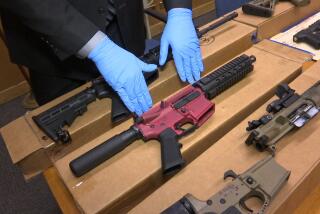Study Links Gun Purchases, Suicide
A California study in today’s New England Journal of Medicine suggests that restricting people’s ability to buy handguns can substantially reduce the suicide rate.
The study, conducted by the Violence Prevention Research Program at UC Davis, has found that gun buyers, especially women, are more likely to kill themselves than are people in the general population, especially during the first week after the purchase.
The study, which tracked more than 238,292 people from 1991, when they bought their firearms, through 1996, said the firearm suicide rate for the buyers was 57 times higher during the first week after their purchases than for the population as a whole.
The rate among gun buyers plummeted after the first year, but it still is double the rate among the general population through the remaining five years of the study.
Although there have been numerous studies showing that gun ownership increases the likelihood of suicides and other firearm deaths in the homes where the guns are kept, this is the first study to track an entire population of gun buyers to compare their suicide rates with the rates in the general population.
It could help refocus the gun control debate on whether firearm regulation is needed more for public health purposes than for crime control purposes.
“The public’s attention had been focused predominantly on gun homicides, but in reality, there have been substantially more gun suicides in most years,” said Dr. Garen Wintemute, an emergency medicine physician and lead author of the study.
“There’s good evidence here that reducing access to guns across an entire population lowers rates of suicides,” he said.
The results have sparked sharp disagreement between pro- and anti-gun forces.
Paul Blackman, a spokesman for the NRA’s lobbying arm, dismissed the significance of the study.
“It’s not clear that any conclusions can be drawn beyond the fact the 15-day waiting period [for buying a gun] didn’t stop suicides, and that it undermines the anti-gun argument that suicide is a spur-of-the moment thing that requires a waiting period,” Blackman said.
“If a person is determined to kill himself, he will find a way,” he said.
Kristen Rand of the anti-gun Violence Policy Center in Washington said her organization advocates waiting periods only to give law enforcement authorities time to fully check a buyer’s criminal and mental health background, and not as a cooling-off period.
She said Wintemute’s study “goes a long way to blowing away the argument that handguns are protectors, and it starkly demonstrates the risks of bringing a handgun into the home, particularly for women.”
Whatever its implications for gun regulation, the study amply demonstrates that the decision to buy a handgun and keep it in the home is a life-or-death one, said Arthur Kellerman, chairman of emergency medicine at the Emory School of Medicine at the University of Georgia.
“We’ve known for years that marketing handguns for protection is commonly followed, but that benefit has to be balanced against the increased likelihood of suicide, family violence, homicides and accidental shootings.”
Wintemute’s study used the California Justice Department’s gun records to identify the buyers and state death records to determine which ones died and how they died. Wintemute said the suicide rates are probably conservative because gun purchases through licensed dealers mean that the buyers had clean criminal records. Moreover, other factors that lead to suicide, such as a history of violence and alcohol or drug abuse, are probably less prevalent among the gun buyers in his study.
Under California law, purchasers had to wait 15 days for the background check before they could take possession of the gun.
Throughout the six-year period studied, 22,602 Californians committed suicide. Altogether, guns are the single most used instrument of suicide, accounting for more than half the deaths, a rate that is slightly below the national average.
Wintemute’s study found that the suicide rate among gun buyers during the first week jumped to a rate of 650 suicides for every 100,000 Californians. For the first month, the rate averaged close to 375, which is 34 times greater than the average for the general population.
Wintemute said the dramatic spike in gun suicides during the first few weeks after the purchase indicates that the individuals may have bought the gun solely to commit suicide.
Nearly a quarter of the gun buyers who died during the first year after the purchase did so by suicide; among young women, more than half the deaths were by suicide, and most of those were with a gun.
Robert Spitzer, a political science professor at New York College at Cortland and author of “Politics of Gun Control,” said: “The policy implications from the study are pretty clear--the availability of guns matters when it comes to the harm they produce in society. It encourages the idea that guns should be more strictly regulated.”
He said it also raises the question of whether background checks need to be expanded to find people who suffer from mental instability.
“Current background checks for criminal record are good, but they are not sufficient for checking mental health backgrounds.”
(BEGIN TEXT OF INFOBOX / INFOGRAPHIC)
Suicide by Handgun
Here is the rate of suicides by firearm per 100,000 people among Californians who bought handguns in 1991 during the six years following the purchase. The heavy line represents the average annual rate of suicides by firearm in the state from 1991-96 per 100,000 people.
*
Sources: New England Journal of Medicine, Violence Prevention Research Program at UC Davis






